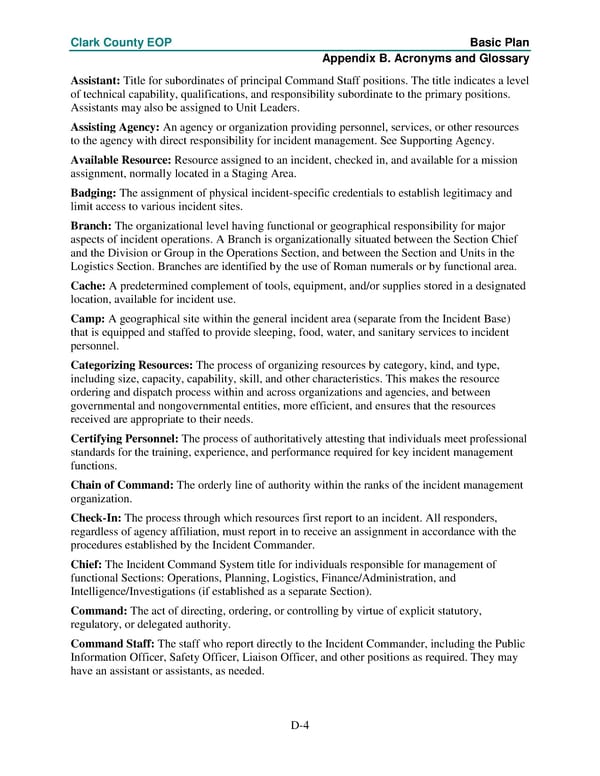Clark County EOP Basic Plan Appendix B. Acronyms and Glossary Assistant: Title for subordinates of principal Command Staff positions. The title indicates a level of technical capability, qualifications, and responsibility subordinate to the primary positions. Assistants may also be assigned to Unit Leaders. Assisting Agency: An agency or organization providing personnel, services, or other resources to the agency with direct responsibility for incident management. See Supporting Agency. Available Resource: Resource assigned to an incident, checked in, and available for a mission assignment, normally located in a Staging Area. Badging: The assignment of physical incident-specific credentials to establish legitimacy and limit access to various incident sites. Branch: The organizational level having functional or geographical responsibility for major aspects of incident operations. A Branch is organizationally situated between the Section Chief and the Division or Group in the Operations Section, and between the Section and Units in the Logistics Section. Branches are identified by the use of Roman numerals or by functional area. Cache: A predetermined complement of tools, equipment, and/or supplies stored in a designated location, available for incident use. Camp: A geographical site within the general incident area (separate from the Incident Base) that is equipped and staffed to provide sleeping, food, water, and sanitary services to incident personnel. Categorizing Resources: The process of organizing resources by category, kind, and type, including size, capacity, capability, skill, and other characteristics. This makes the resource ordering and dispatch process within and across organizations and agencies, and between governmental and nongovernmental entities, more efficient, and ensures that the resources received are appropriate to their needs. Certifying Personnel: The process of authoritatively attesting that individuals meet professional standards for the training, experience, and performance required for key incident management functions. Chain of Command: The orderly line of authority within the ranks of the incident management organization. Check-In: The process through which resources first report to an incident. All responders, regardless of agency affiliation, must report in to receive an assignment in accordance with the procedures established by the Incident Commander. Chief: The Incident Command System title for individuals responsible for management of functional Sections: Operations, Planning, Logistics, Finance/Administration, and Intelligence/Investigations (if established as a separate Section). Command: The act of directing, ordering, or controlling by virtue of explicit statutory, regulatory, or delegated authority. Command Staff: The staff who report directly to the Incident Commander, including the Public Information Officer, Safety Officer, Liaison Officer, and other positions as required. They may have an assistant or assistants, as needed. D-4
 Emergency Operations Plan Page 107 Page 109
Emergency Operations Plan Page 107 Page 109